Everything You need to Know to Be Ready for the Upcoming Sunset of Universal Analytics


To help ensure our customers and potential future customers fully understand the changes coming with Google Analytics 4 and are ready to start collecting useful data on July 1, 2023, Zmags’ Vice President of Product, Allison Vernerey led a conversation with Gideon Delayahu, a digital analytics expert and owner of Digital Insights. (Zmags and Digital Insights have worked together to ensure the GA4 readiness for a mutual customer.)
Gideon founded Digital Insights 8 years ago to provide custom performance and analytics solutions to small and medium businesses. He notes that the custom nature of the work certainly makes it harder, but also more interesting and more impactful for customers. The discovery and planning process is the most critical step in ensuring relevant and meaningful insights are uncovered.
This is not the first time Digital Insights has led clients through updates to data collection tools, but Gideon does emphasize that despite the tools changing from time to time over the last 15 years – the needs of the business have not changed. At the end of the day, different members of the organization need visibility into data and insights regarding website traffic in order to make decisions.
It’s even more of a focus now than it was 15 years ago, as teams have come to expect a certain amount of data and level of insights to be available to them. Picking out what is important and not, and what tools to use, has become more difficult over time.
A Look Back to How We Got Here
Most people have heard already that Universal Analytics (UA) will be retired on June 30th, but some might not know why, or why it matters. Gideon provides some history dating back to the Netscape Navigator era of the mid 1990s.
At the time, websites were really simple – pages were just content with no interaction. You simply had a counter to show how many people visited or consumed a page. As websites became more interactive, it forced tracking to progress as well. Eventually it became quite an ordeal to capture everything that happens – not just where they come from, but what they do, and how they interact with the page.
Google Analytics had been around for about 16 years before GA4 was developed. One of the earliest mechanisms for tracking was UTM (Urchin Tracking Module) parameters, which some may recognize as the text after a question mark in a URL. It was a technology built by Urchin Software Company and bought by Google in 2005, laying the groundwork for Google Analytics.
Though tried and true, over time the old technology was slowing Google down – they were having latency and sampling issues that led them to look for a new way of working. With General Data Protection Regulation (GDPR) and California Consumer Privacy Act (CCPA) came additional privacy concerns that forced a change. The older Google Analytics is based on cookies. GA4 is using other methods to avoid cookies. The official line from Google is that GA4 has been built to provide a more user-centric approach, but there are real practical reasons as well. The architecture of the data is to provide a solution for those two problems.
In-Session Survey Results

NOTE: If you haven’t started setting up GA4 yet, you’re not alone. And it’s not too late! Reach out to Zmags or Digital Insights for help.
What are the differences between Universal Analytics and Google Analytics 4?
According to Gideon, you will mainly see tactical improvements, not a huge leap forward in what the tool does. GA4 is providing the same service – information about who comes to your site, where they landed, what they did. You still need to tailor the tool to your business, and even deeper than that – what individual teams within your business need to know.
As it always has been, how you configure it remains important. If you get rubbish in, you get rubbish out. GA4 doesn’t use cookies for user identification. No cookies means the new data structure is event based. In the past, you had pageviews and events, you couldn’t share data between the two. Ecommerce data was standalone, and you couldn’t mix it with other pieces of information. The new data schema is more flexible and more granular, which is very much a positive.
Another benefit of GA4 and something that they couldn’t provide with the old data structure, is the integration of Machine Learning into the tool itself. It learns over time, so it’s not fully capable yet, but there is the promise that it will begin providing very useful insights to users, without the intervention and interpretation of analytics experts and consultants.
Other important new benefits include:
- Increased flexibility, helping ensure that businesses are getting what they need.
- A robust data architecture that lends itself well to future integrations.
- A more user-focused presentation and new structure that allows you to stitch together visit data by the same person across browsers or devices.
What issues might people face in adopting GA4?
Without scaring people who haven’t made the move yet, let’s take a look at a few not-so-great parts about this forced migration.
The interface of the tool is really different than Universal Analytics and difficult to navigate, especially if you’re used to the old way. You must re-learn a lot of stuff to use it.
Additionally, some features did not carry over in the new platform. Goals is one example. There are other ways to look at the same things, but if those were key to how your business was working, you do need to make changes.
Overall, Gideon’s opinion is that GA4 still feels “half-baked.” They are still releasing updates regularly and changing the interface and even the data structure. The tool could have been “in the oven” for a bit longer before it was put in front of customers.
What’s more, the migration process itself is not smooth. Because you’re running GA4 and Universal Analytics in parallel, you get two different data sets. They align sometimes, but not always. Then the business starts to question the data, and that distrust can be paralyzing.
And finally, Universal Analytics had a lot of expertise and resources that people could turn to in order to find an explanation or how to do something. There's not that level of depth yet for GA4, making it hard for people to work through and learn.
In-Session Survey Results

What does a “typical” GA4 setup look like?
There is no typical implementation because no business is the same. Out of the box doesn’t exist when it comes to your analytics setup. Here’s an example:
If somebody comes to your website from a social post, and then you have them log in, then they leave briefly to checkout via Paypal and comes back – you might not attribute the sale correctly if you have a standard set up.
There are also business-specific interactions, parts of the page that are truly unique to your business, that Google Analytics wouldn’t recognize without some direction.
Gideon walks us through an example from the Heal’s Furniture website, keeping our focus on the datalayer view so we can see what’s being tracked as he explores the site. Here’s the journey:
Searched for product on Google. Clicked on ad. Visit Heal’s website. This is where the tailoring of the implementation starts. There are a lot of elements that are interesting to the business. The 360-degree view which comes from a third-party provider. A user can also make selections to configure the product variants. There's a review to read. There’s a widget to design a room which comes from another third-party provider. There’s more info about delivery and product specs. There’s a lot on this page. A lot of this won’t be captured in a meaningful way, if not configured correctly.
Let’s look at the data where we can see what is captured and sent to Google Analytics. One thing they’ve added is that you can have an almost-unlimited number of parameters for a single event. With UA – there were only 3 – category, action, and label. You can also see where people came from (not just the singular visit, but the user’s original entry source as well).
In this case, they’ve created a custom event for PDP Interaction, and you can see not just that they clicked on a tab, but which of the tabs they clicked on.
The key takeaways: Make sure you’re meeting the business need – you have the ability to surface almost anything. Take that step back and really understand the customer’s journey.
What’s important for companies that are working with multiple third parties?
Having communication not just with the client, but directly with the other third party, is important. Each party can lose a lot of information through translation if you don’t have that direct interaction.
Fastr Frontend provides a more dynamic and interactive experience, so it was important to understand how Heal's is using the platform to help them figure out what information is important for them to know.
In this case, for a Fastr Frontend experience the business wants to know what experience is being shown including the experience type, name, what the interaction, and which scene of an experience. With that you can start to piece together what the user saw and did through the events.
Here’s an example of the additional detail you can set up and see with GA4, as compared to the original three parameters available in UA.
Fastr Frontend & GA4
As a technology platform that helps companies create engaging content and improve customer journeys, we recognize how critical it is for our customers to have visibility into the effectiveness of the experiences created through Fastr Frontend. We want to give you the data you want in the way that you want it.
There are 4 types of events in GA4: Automatic, Enhanced, Recommended, and Custom. You can access a detailed explanation of these different types of events via the Fastr Community alongside other FAQs about integrating GA4 and Fastr Frontend, or you can dive deep into event definitions directly from Google’s support documentation. In this webinar, we focus on explaining the two types of GA4 integrations available with Fastr Frontend, and these differ based on the types of events tracked with each configuration.
With Zmags – you can choose between two types of setups. A basic setup lets you collect Automatic and Enhanced events. And the great news is that (as long as you’re using our Enhanced Server-side Rendering code snippet), Fastr Frontend experiences are just like native content on your site. That means that information will come through automatically for these types of events – you don’t need to do anything.
If you want to set up GA4 with more specific business needs like Gideon outlined in the webinar, then you can have an advanced setup. If you care about types of experiences, like banners or carousels, or the types of interactions (different types of clicks), this is the configuration for you.
To help you get started with GA4 and get the most out of your analytics tool, we’re happy to offer a complimentary advanced setup to customers that are already using or upgrade to Fastr Frontend before June 30th. Reach out to your Customer Success Manager for more information, and watch the full webinar with Gideon on-demand to fully understand what GA4 can do for your business.